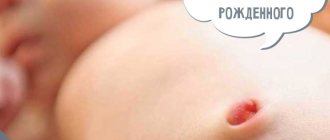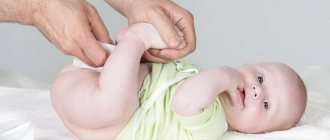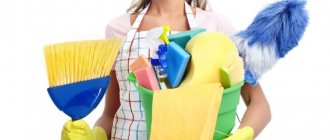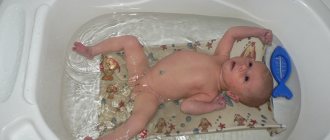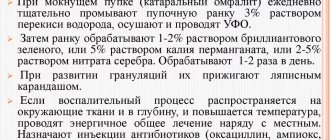» Signs » Signs about the umbilical cord of a newborn
0
3447
Article rating
The birth of a baby is the greatest miracle on earth. They began to care about the baby’s well-being only after learning about his imminent appearance. Even in ancient times, a lot of beliefs and signs appeared that connected an unborn child with his future. A special place among them is occupied by the umbilical cord of a newborn. After all, this is a small tube that connects a woman with her child for all nine months. Through this thread the baby ate, breathed, listened to mom and dad. Therefore, you need to know where to put it after the birth of the baby, so as not to harm the child on the astral level.
Signs about the umbilical cord of a newborn
Symbolism of the umbilical cord
A baby who has just been born is absolutely pure and has not yet sinned in any way. Therefore, in the distant past, there were beliefs that at the moment of birth all sorts of otherworldly forces began to fight for the soul of the baby. Parents had to take measures to protect the baby from all evil spirits. To do this, I definitely need to know what to do with the fallen umbilical cord of a newborn.
At all times, a large number of signs and customs have been associated with the umbilical cord. Some of them appeared due to belief in the other world.
For many peoples, the navel is considered a living creature. If a child was born entwined with an umbilical cord, then it is an enemy, and if not, then it is a friend. Sometimes she was called brother, sometimes sister, of a little man who had just come into our world. It also happens that the umbilical cord is considered a thing in which there is a piece of the child’s soul or a spirit that is the guardian of the newborn. Therefore, the clothespin with the navel was not thrown away, but kept in a secluded place somewhere in the house.
In the Caroline Islands, the umbilical cord remains are placed in a vessel with ash. The magic vessel is then placed on the tree among the branches so that it can monitor the future of the newborn.
Baby's umbilical cord - signs and traditions
There are many superstitions about what to do with a newborn’s umbilical cord.
- Some peoples needed to quickly bury it in the ground. In the garden or somewhere in the yard, not far from outbuildings - if a girl was born. Or in a field, in a forest, outside the outskirts - if a boy was born.
- Sometimes the signs of our ancestors advised storing the umbilical cord of a child until he reaches the age of seven.
It was first tied in a knot and dried. If the baby was sick, he was doused with water flowing down precisely this “magic bundle.” Such a ritual was considered the best remedy for protection against induced damage and all kinds of natural ailments.
Signs about the future
Some of the signs associated with the umbilical cord appeared as a result of observing the expectant mother and the newly born baby. Different peoples had different beliefs that were passed on from generation to generation. Some of this has survived to this day.
- In most European countries, people believe that the future of a baby is connected with what is done to the navel. What could not be prophesied to the little man from a piece of his navel. In Germany, the umbilical cord remains are wrapped in a piece of old canvas. Then, if the umbilical cord belongs to a newborn girl, the bundle is pierced so that in the future the little girl will become a skilled seamstress. If the owner of the navel is a boy, then the canvas bundle is cut into pieces. Then in the future the guy will become a good worker.
- In France, to prevent a newborn from drowning or burning in the future, it is prohibited to throw a fallen piece of the umbilical cord into fire or water.
- In Mexico, warriors buried a boy's navel on the battlefield. They believed that in the future the boy would become a great warrior. And the girl should become a good housewife and keeper of the home, so the girl’s belly button was buried close to the house.
- But the indigenous people of Western Australia, if they want the baby to become a good swimmer in the future, lower its umbilical cord into the water.
- Some Indian tribes hung a boy's navel from one of the trees. They believed that when this baby grew up, he would be a skilled hunter. In order for a girl to become a good cook, her umbilical cord was hidden under a container of grain. In the distant past, there were beliefs that the umbilical cord was connected with the baby for life, and health and life were directly related to the integrity and safety of the fallen umbilical cord.
- In Berlin, the midwife dries the umbilical cord and hands it to the parent. The father must guard it like the apple of his eye, then the owner of this navel will live in health until old age.
- The Inca Indians kept the navel with special care. If the little man suddenly got sick, he was allowed to suck on it.
- In Serbia, the umbilical cord, wrapped in a piece of material, was kept in a chest. At the same time, it had to be dried on a fruit tree. In Slovenian families, the mother kept the navels of all her children together, believing that this way her children would always be friends. If a quarrel did break out, the umbilical cords were tied with several knots.
What to do when the umbilical cord falls off?
When the navel falls off, no matter what day it happened, a small wound remains in this place. It should continue to be treated twice a day - after the baby wakes up and before bed, preferably after bathing.
Processing consists of several stages:
- 2-3 drops of hydrogen peroxide are dripped from a pipette into the navel area, or a cotton pad moistened with this liquid is applied. This procedure removes dirt from the wound, soaks the formed crusts, and prevents bacteria from entering it;
- After foaming stops, the soaked crusts are removed with the edge of a dry cotton swab. During the cleaning process, which should be done quite carefully, the navel can be slightly spread with your fingers without causing pain to the baby;
- After cleaning, the treated area should be allowed to dry a little;
- lubricate the wound with brilliant green applied to a cotton swab. The area around the wound should not be treated with brilliant green. Sometimes potassium permanganate and an alcohol solution of chlorophyllipt are used for this.
Mandatory treatment until the umbilical wound is completely healed is recommended by all experts to be done in the same way. But regarding bathing during this period, their opinions are divided. And since there is no clear answer to the question of whether to bathe or not to bathe, they leave the decision to the discretion of the parents.
When bathing a child, you need to consider the following recommendations:
- bathe only in boiled water;
- the water should have a temperature that is comfortable for the baby;
- use only a special separate baby bath;
- Before bathing, disinfect the water with a weak solution of potassium permanganate, making sure that its crystals do not get on the child’s skin;
- After bathing, do not wipe the wound, but pat dry with a clean towel.
During this period you should also:
- At normal temperatures in the room, keep the baby naked for a long time. Air baths in a well-ventilated area will help dry the wound and speed up healing;
- dress the child only in clean and ironed clothes;
- bend the edge of the diaper, leaving the umbilical wound free from it;
- ensure dryness in the navel area.
The process of complete healing of the umbilical wound usually takes 1-2 weeks. That's when the last crust falls off. And the skin tone of the healed navel completely matches the skin of the baby’s abdomen.
Signs from ancient Rus'
The umbilical cord could be a talisman
In Rus', there were also signs and beliefs associated with the navel of a newborn. Some of them have survived to this day.
- In ancient times, women gave birth at home. And their birth attendants were midwives. As soon as the baby was born, the midwife cut the umbilical cord and tied it with a knot. The navel was tied with a red wool thread.
- The boy's umbilical cord had to be cut either on an oak block, or on an ax handle, or on a book. This foreshadowed that the newborn would become strong, be able to wield various instruments, and be literate.
- The girl's navel had to be cut off on an alder die. Then in the future the newborn will become a good housewife and will not shy away from any work.
- If a woman gave birth to her first baby, they used his umbilical cord to tell fortunes. The number of thickenings on it indicated how many more children the woman would have.
- The umbilical cord bundle was stored dried for several years. After this, on the seventh birthday, the child was given this knot to untie it. This is how mental and physical abilities were “unleashed.” The child was supposed to become happy in the future if he managed to untie the knot, otherwise good things were not expected.
- Many mothers believed that the navel has healing qualities. When the child was bathed, she was lowered into the water. Water was poured onto a frequently ill child through the umbilical cord, thus trying to “wash away” the sores from their child.
- In ancient Rus', the umbilical cord served as a talisman for guys going to serve in the army and girls who were going to get married.
When and how does it disappear
Some babies arrive home without a clothespin - the stump falls off while still in the maternity hospital. The normal time frame for separation of umbilical cord remnants is determined to be 4-10 days.
For some, the clothespin lasts much longer – up to 14 days or more, which is not considered a pathology, but rather a characteristic of the body.
The drying unnecessary stump separates on its own during sleep and bathing. Mom discovers a clothespin with a piece of dried umbilical cord and a small wound at the attachment site.
Important: if the clip comes off, but the stump remains on the body, the clothes clip should be returned to its place. The remainder of the umbilical cord and the clamp are first thoroughly disinfected.
While the clothespin is still attached to the baby, that is, the time for the umbilical cord to fall off has not yet arrived, you need to handle the baby especially carefully. Try not to touch the clothespin, do not get it wet, do not overtighten with diapers, and allow the skin to breathe.
Warning sign
For many centuries, a popular belief has been passed on from mouth to mouth: during pregnancy you should not engage in any kind of needlework involving threads. This leads to the fact that the umbilical cord may become entwined around the baby's neck or knots may appear on the umbilical cord.
This is one of the few signs that has a basis. The roots of this belief stretch from the distant past, when there were no maternity hospitals and births were delivered by midwives, not midwives. Many women have given birth to babies with the umbilical cord entwined. Due to the inexperience of the midwives, the child died. To justify their mistakes, midwives said that the woman did a lot of needlework during pregnancy: weaving lace, knitting, sewing, embroidering. This is how I brought such trouble upon the child.
Modern signs during pregnancy
In the modern world, many signs have been forgotten, but there are beliefs that are still relevant.
Here are the most cautionary beliefs:
- During pregnancy, you should not do anything that might involve handicrafts. This puts the baby at risk of being wrapped in the umbilical cord during birth.
- You can't cut your hair. Hair is a woman’s life force; if you shorten it, you can shorten the baby’s life.
- You can't look at open fire.
- You can’t look at something ugly, ugly.
- You cannot rock an empty cradle, crib or stroller, as evil spirits can occupy it.
- You should not eat sweets at night, so that the child does not develop a tendency to take someone else’s without asking.
- You cannot buy things and household items for a child before his birth.
Where to put the umbilical cord of a newborn
Hi all! One thing has always surprised me. When you are preparing for childbirth, you read as much material as possible, communicate with those who have gone through it. But when you find yourself alone with a toddler, you get lost. You forget everything completely. Sound familiar?
And one of the challenges that parents face at first is caring for the umbilical cord. The biggest question is how to treat a newborn's belly button after it falls off. Let's try to figure this out today.
What not to do with your belly button
Don’t be afraid to touch the umbilical cord or umbilical wound when processing them! Kids may, of course, experience some discomfort, but it doesn’t hurt them. Caring for the umbilical wound should be especially careful, since it can serve as an entry point for infection, which can result in first catarrhal and then purulent omphalitis - inflammation of the tissue around the umbilical wound.
In cases where there is prolonged “wetting” of the wound (more than 2 weeks), bloody, purulent or other discharge from it, you must consult a doctor! Do not try to treat your baby yourself: it may be unsafe for him.
The wound should not be under a gauze or disposable diaper, as this makes it difficult for the crust to dry, causes weeping and thus prevents the rapid healing of the wound and contributes to the possible addition of infection. Sometimes additional irritation of the skin of the peri-umbilical area is observed. To avoid this, you should bend the waistband of the disposable diaper so that the navel area remains open.
How does healing proceed?
In a maternity hospital, the main care for a newborn falls on medical staff. Nurses show inexperienced parents the important basics of wound treatment, washing, and cleansing the skin. But after discharge, the mother must continue daily procedures on her own. The natural question is what to do with the clothespin? How and after how many days does the belly button fall off?
There are several stages of healing of the umbilical wound:
- Cutting the umbilical cord, forming a neat stump using a clothespin clamp.
- Within 3–4 days, the ichor is released. Normally, there should be no dark blood, clots, or unpleasant odor. With proper care and treatment, the discharge stops on the 4th day.
- During the healing process, drying crusts may remain that cannot be torn off abruptly. They are carefully removed using antiseptics.
- Careful care of the navel is necessary for 2–3 weeks. After complete healing, the wound will become light and the navel will retract inward.
According to the medical norm, the navel of a newborn with a clothespin disappears between 4 and 10 days. For some babies, healing begins only at 14 days. This depends on the individual characteristics of the newborn’s body, the rate of cell regeneration, and the presence of infection.



